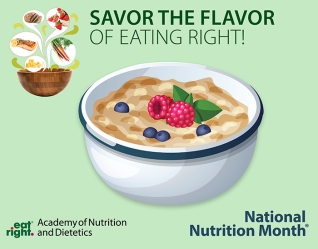March is National Nutrition Month®! This year the Academy of Nutrition and Dietetics is encouraging everyone to learn how to “Savor the Flavor of Eating Right” while still following a healthy eating pattern.

The 2015-2020 Dietary Guidelines recommend limiting the amount of added sugar, sodium and saturated fats that you eat. Limiting these components can help meet food group and nutrient needs within your recommend calorie limit for weight management [1].
Today we are going to take a closer look at reducing added sugars!
What are added sugars?
Added sugars are sugars and syrups that are added to foods or beverages when they are processed or prepared. This does not include naturally occurring sugars such as those in milk and fruits [2].
Common added sugars and syrups that are added to foods or beverages include [2],[3]:
- Agave Nectar
- Brown sugar
- Date sugar
- Dextrose
- Cane sugar
- Coconut sugar
- Corn sweetener
- Corn syrup
- Fruit juice concentrates
- High-fructose corn syrup
- Honey
- Invert sugar
- Maple Syrup
- Malt sugar
- Molasses
- Raw sugar
- Sugar
- Syrup
The 2015 – 2020 Dietary Guidelines recommend consuming <10 percent of your daily calories from added sugars [1].
Challenge: Choose one tip to try this week to reduce YOUR added sugar consumption:
- Read food labels and avoid buying foods with added sugars. You can identify added sugars under the ingredients section on a nutrition facts label.
- Drink water, low-fat or fat-free milk and 100-percent fruit or vegetable juice instead of sugary beverages.
- Choose snacks with no added sugar. For example, try plain yogurt with berries instead of flavored yogurt or almonds mixed with raisins instead of store bought trail mixes.
- Buy food products that say unsweetened verses original such as non-dairy milks, applesauce, and dried fruits.
- When baking cookies, brownies or cakes, try cutting the sugar called for in your recipe to one-half of the amount ( 1 cup to 1/2 cup). I promise you won’t notice the difference!
To find out more about how you can reduce your added sugar consumption, contact a Registered Dietitian in your area, the Idaho Nutrition Experts.
The Academy’s website (eatright.org) includes helpful articles, recipes, videos and educational resources to spread the message of good nutrition and an overall healthy lifestyle for people of all ages, genders and backgrounds. Consumers are also encouraged to follow National Nutrition Month® on the Academy’s social media channels including Facebook and Twitter using the #NationalNutritionMonth hashtag.
Resources:
-
“Added Sugars.” Choose MyPlate. USDA, 09 Dec. 2015. Web. 28 Feb. 2016. <http://www.choosemyplate.gov/added-sugars>.
-
“Sugar 101.” Sugar 101. American Heart Association, n.d. Web. 28 Feb. 2016. <http://www.heart.org/HEARTORG/HealthyLiving/HealthyEating/Nutrition/Sugar-101_UCM_306024_Article.jsp#.VtOiwPkrKUk>.
-
“Key Recommendations: Components of Healthy Eating Patterns.”Health.gov. Office of Disease Prevention and Health Promotion, 2016. Web. 28 Feb. 2016<http%3A%2F%2Fhealth.gov%2Fdietaryguidelines%2F2015%2Fguidelines%2Fchapter-1%2Fkey-recommendations%2F>.